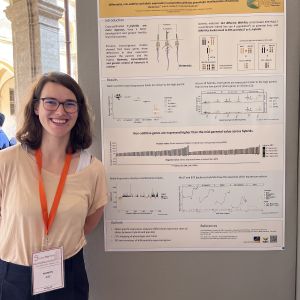Bionote

I am a doctoral researcher at the University of Bonn, affiliated with the Institute of Crop Science and Resource Conservation (INRES) in the Crop Functional Genomics lab of Frank Hochholdinger. My research focuses on the genetic and transcriptomic diversity of maize, particularly in relation to heterosis. Currently, I am collaborating with the Lipka Lab at the University of Illinois Urbana-Champaign to perform a simulation study on transcriptome wide association analyses. Prior to pursuing a PhD, I worked as a project manager in a software development company, specializing in agriculture and farming applications.
Presentation Abstract
Uncovering the genetic basis of quantitative traits has long been of high importance for researchers, breeders, and geneticists. Identifying causative genes and loci can inform breeding strategies, elucidate molecular pathways underlying complex traits, and shed light on evolutionary processes. While genome-wide association studies (GWAS) and quantitative trait loci (QTL) studies have been instrumental in identifying genomic loci associated with quantitative traits, transcriptome-wide association studies (TWAS) offer a complementary approach by directly correlating gene expression levels with phenotypic traits. The same methods, originally developed for GWAS, are often applied to transcriptomic data. However, structural differences between transcriptomic and genomic datasets exist, ranging from correlations between gene expression of different genes to varying distributions of expression values. Furthermore, the plethora of available tools and mathematical methods can be overwhelming. This study aims to investigate the strengths and limitations of using GWAS methods for TWAS. By reanalyzing transcriptomic data from maize and simulating associations between gene expression and phenotype with diverse underlying expression patterns, we provide insights into the key factors influencing TWAS outcomes. The use different datasets generated from recombinant inbred lines and their backcross populations as well as maize diversity panels will be used to identify possible influences of different populations structures. Our preliminary results highlight the importance of considering effect sizes of associations and correlated gene expressions when conducting TWAS. By exploring these factors and evaluating the performance of mixed linear modelling and derivative approaches, we will contribute to the development of more effective strategies for TWAS.
Co-Researcher: Frank Hochholdinger, Alex Lipka